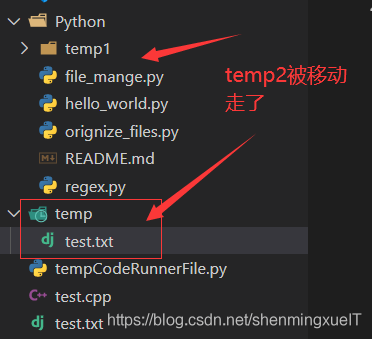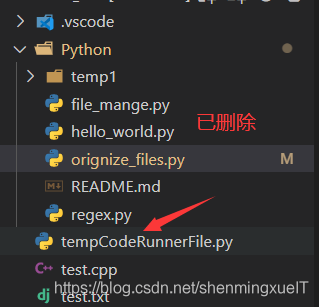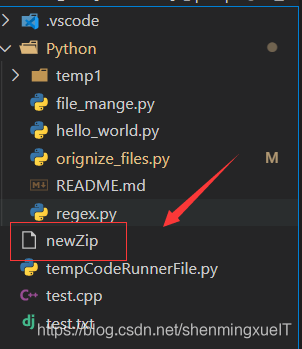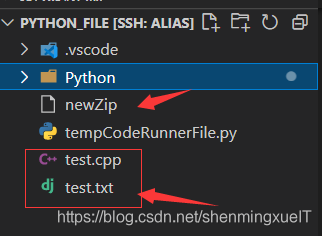python基础学习之组织文件
作者:shenmingik
一、Shutil 模块
shutil其实也就是shell模块。其中包含一些函数,可以让我们在python程序中复制、移动、改名和删除文件。
1.1 复制文件和文件夹
- shutil.copy(source,destination):将路径source处的文件复制到路径destination处的文件夹。如果destination是一个文件名,那么它将作为被复制的新名字
- shutil.copytree(source,destination):将路径source处的文件夹,包括它的所有文件和子文件夹,复制到路径destination处的文件夹。
import shutil import os current_path = os.getcwd() # 拷贝test.txt 文件到temp1文件夹下 shutil.copy(current_path+"/test.txt",current_path+"/Python/temp1") # 将temp1文件夹内容拷贝到temp2文件夹下,此时会创建temp2文件夹 shutil.copytree(current_path+"/Python/temp1",current_path+"/Python/temp2")
结果:

1.2 移动文件和文件夹
- shutil.move(source,destination):将source处的文件夹移动到路径destination,并返回新位置的绝对路径的字符串
注:
如果destination指向一个文件夹,source文件将移动到destination中,并保持原来的文件名;
如果destination指向一个文件,这个文件就会被覆盖,注意!
如果destination指向一个不存在的文件夹,这个时候source里面的内容会移动到destination,source改名为destination
import shutil import os current_path = os.getcwd() # 将temp2文件夹内的文件拷贝到temp中,并将temp2改名为temp shutil.move(current_path+"/Python/temp2",current_path+"/temp")
结果:

1.3 删除文件和文件夹
- os.unlink(path):将删除path处的文件
- os.rmdir(path):将删除path处的文件夹。该文件夹必须为空,其中没有任何文件和文件夹
- shutil.retree(path):将删除path处的文件夹,它包含的所有文件和文件夹都会被删除
import shutil import os current_path = os.getcwd() shutil.rmtree(current_path+"/temp")
结果:

二、遍历文件
- os.walk(path):通过传入一个路径
os.walk()在循环的每次迭代中,返回三个值:
1.当前文件夹名称的字符串
2.当前文件夹中子文件夹的字符串的列表
3.当前文件夹中文件的字符串的列表
import shutil
import os
current_path = os.getcwd()
for folder_name,sub_folders,file_names in os.walk(current_path):
print(folder_name+":")
# 加载当前文件路径下的所有子文件
for sub_folder in sub_folders:
print("\t"+folder_name+": "+sub_folder+"(dir)")
for file_name in file_names:
print("\t"+folder_name+": "+file_name)
输出(部分):
ubuntu@VM-0-2-ubuntu:~/python_file$ /usr/bin/python3 /home/ubuntu/python_file/Python/orignize_files.py
/home/ubuntu/python_file:
/home/ubuntu/python_file: .vscode(dir)
/home/ubuntu/python_file: Python(dir)
/home/ubuntu/python_file: test.cpp
/home/ubuntu/python_file: test.txt
/home/ubuntu/python_file: tempCodeRunnerFile.py
/home/ubuntu/python_file/.vscode:
/home/ubuntu/python_file/.vscode: db(dir)
/home/ubuntu/python_file/.vscode: .git(dir)
/home/ubuntu/python_file/.vscode: log(dir)
/home/ubuntu/python_file/.vscode: settings.json
/home/ubuntu/python_file/.vscode/db:
/home/ubuntu/python_file/.vscode/db: cpptips.db-wal
/home/ubuntu/python_file/.vscode/db: cpptips.db-shm
/home/ubuntu/python_file/.vscode/db: cpptips.db
/home/ubuntu/python_file/.vscode/.git:
/home/ubuntu/python_file/.vscode/.git: 6eb7a60f73d1a1d9bdf44f2e86d7f4cc_test.cpp
/home/ubuntu/python_file/.vscode/log:
/home/ubuntu/python_file/.vscode/log: cpptips.server.2021-05-19.log
/home/ubuntu/python_file/.vscode/log: cpptips.server.2021-05-16.log
/home/ubuntu/python_file/.vscode/log: cpptips.server.2021-05-17.log
/home/ubuntu/python_file/.vscode/log: cpptips.client.log
/home/ubuntu/python_file/.vscode/log: cpptips.server.log
/home/ubuntu/python_file/Python:
/home/ubuntu/python_file/Python: temp1(dir)
/home/ubuntu/python_file/Python: .git(dir)
/home/ubuntu/python_file/Python: README.md
/home/ubuntu/python_file/Python: hello_world.py
/home/ubuntu/python_file/Python: orignize_files.py
/home/ubuntu/python_file/Python: regex.py
/home/ubuntu/python_file/Python: file_mange.py
.........
.........
.........
三、压缩文件
利用zipfile模块中的函数,python程序可以创建和打开ZIP文件。
3.1 创建和添加ZIP文件
想要创建ZIP文件,必须用ZipFile方法创建一个ZipFile对象。ZipFile对象在概念上和File对象相似。
之后,以写模式打开这个对象。调用write()方法传入一个路径,python就会压缩该路径所指的文件,将它加到ZIP文件中。write的第一个参数是一个字符串,代表要添加的文件名。第二个参数是”压缩类型“参数,告诉计算机使用怎样的算法来压缩文件。一般来说,ZIP_DEFLATED就可以了。
import zipfile
import os
current_path = os.getcwd()
new_zip = zipfile.ZipFile("newZip","w")
new_zip.write("test.txt",compress_type=zipfile.ZIP_DEFLATED)
new_zip.write("test.cpp",compress_type=zipfile.ZIP_DEFLATED)
结果:

3.2 读取ZIP文件
当用ZipFile函数打开一个zip文件的时候,会返回一个ZipFile对象。之后调用这个对象的namelist()方法就可以获得zip里面的压缩文件列表。
同时这个对象还有一个getinfo()方法,通过传入一个压缩文件名,就可以获得这个文件的一些信息。
import zipfile
import os
current_path = os.getcwd()
new_zip = zipfile.ZipFile("newZip","r")
files = new_zip.namelist()
for file in files:
info = new_zip.getinfo(file)
print("filename: "+file)
print("\tsize: "+str(info.file_size))
print("\tcompress_size: "+str(info.compress_size))
输出:
ubuntu@VM-0-2-ubuntu:~/python_file$ /usr/bin/python3 /home/ubuntu/python_file/Python/orignize_files.py
filename: test.txt
size: 26
compress_size: 26
filename: test.cpp
size: 30
compress_size: 28
3.3 解压缩ZIP文件
ZipFile对象的extractall方法从ZIP文件中解压缩所有的文件和文件夹,放到当前工作目录下:
import zipfile
import os
current_path = os.getcwd()
example_zip = zipfile.ZipFile("newZip","r")
# 解压
example_zip.extractall()
example_zip.close()
结果:

四、参考文献
AI Sweigart.Python编程快速上手——让繁琐工作自动化.人民邮电出版社.2016.07
到此这篇关于python基础学习之组织文件的文章就介绍到这了,更多相关python组织文件内容请搜索脚本之家以前的文章或继续浏览下面的相关文章希望大家以后多多支持脚本之家!
您可能感兴趣的文章:
- python基础之文件处理知识总结
- Python关于OS文件目录处理的实例分享
- python引入其他文件夹下的py文件具体方法
- 解决python中os.system调用exe文件的问题
- python使用glob检索文件的操作
- 教你用Python代码实现合并excel文件
- python3 hdf5文件 遍历代码
- Python基础之元组与文件知识总结
- python提取word文件中的所有图片
- python可视化hdf5文件的操作
- Python 如何读取.txt,.md等文本文件
- 教你利用Python破解ZIP或RAR文件密码
- Python文件基本操作实用指南
- Python爬虫之m3u8文件里提取小视频的正确姿势
- python 如何把classification_report输出到csv文件
- 用python删除文件夹中的重复图片(图片去重)
- 将Python代码打包成.exe可执行文件的完整步骤
- Python文件名的匹配之clob库
